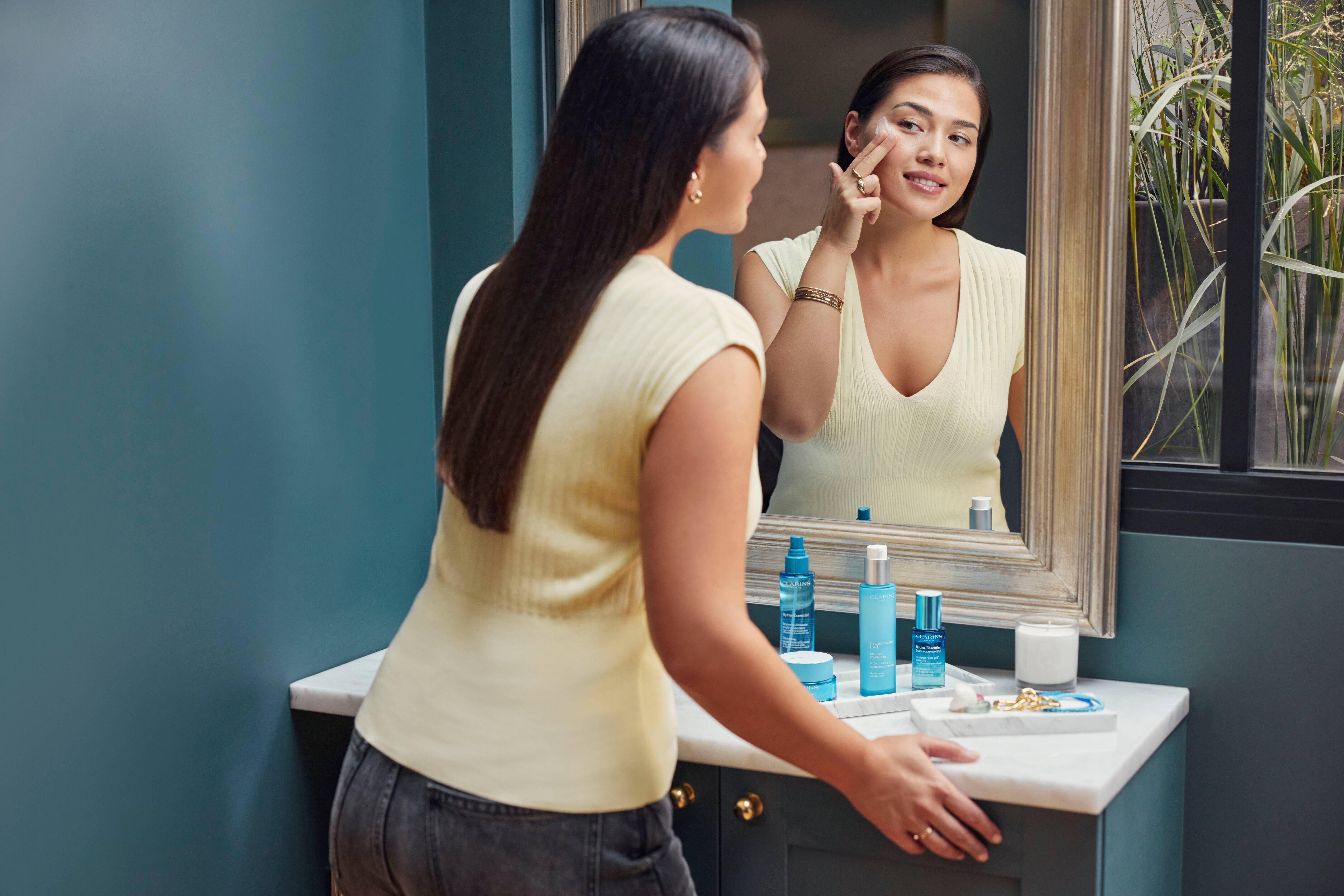
The Best and Worst States for Your Skin
Whether opting for the fresh-faced look or all-out glam, skin health is the foundation of any beauty routine. The right application and products for your skin type can work wonders, but you may still suffer from patches of breakouts, oiliness, and other skin conditions that seemingly feel out of your control. Well, new research for Clarins has uncovered that the state where you live could play a major role in your skin's look, feel, and overall health!
Our study uses insights from third-party government data, looking at how air quality, UV rays, temperature, and humidity impact skin, to uncover the best and worst states for skin health.
States with the Best Environment for Skin Health
Through comprehensive analysis of existing data regarding different environmental factors across the states, Clarins identified which state boasts the best conditions for great skin. The lower the score, the better the state is for our skin.
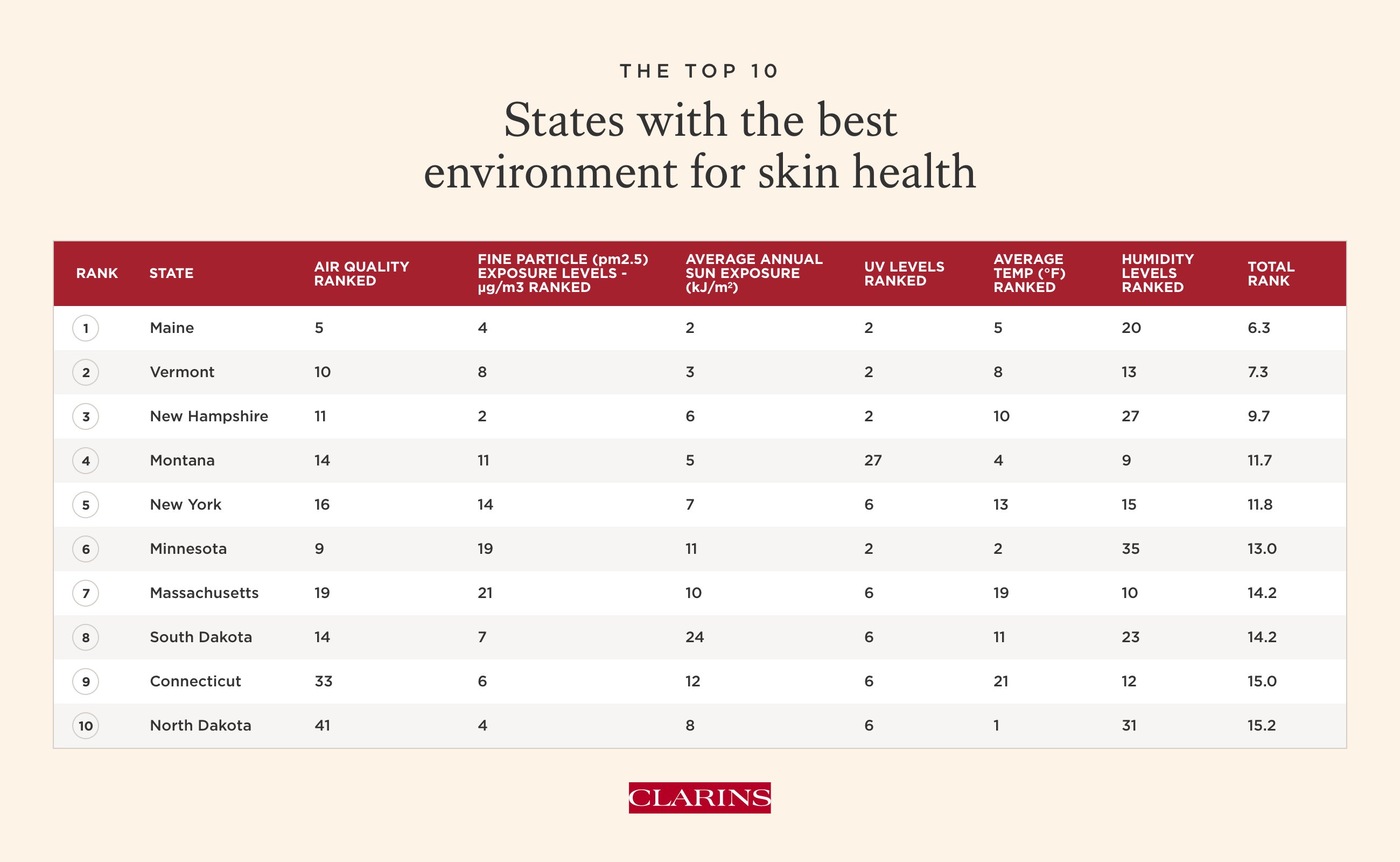
The analysis revealed that the northeastern most state of Maine boasts the best environmental conditions for skin health across the USA, with a score of just 6.3 out of 50.
Maine had the lowest overall score of all states with a particularly low UV level, scoring just 6, 1.7 less than the average UV rays across the US. Maine also ranked low for air quality and pollution levels, with a 5.4 PM2.5 exposure level, one of the lowest in America.
With a score of 7.3 out of 50, Vermont claimed second position. Similarly to Maine, Vermont ranked low for all environmental factors, especially UV rays, air pollution, air quality, and humidity levels.
New Hampshire secured the third position for best environmental factors for skin health. According to our data, like Maine and Vermont, New Hampshire has exceptionally clean air and low UV rays compared to the rest of America.
Interestingly, the majority of the top 10 best states for skin health are in the Northeast despite much of it being smothered by dense smoke from Canadian wildfires last summer, leading to New York City's worst air quality since the 1960s.
States with the Worst Environment for Skin Health
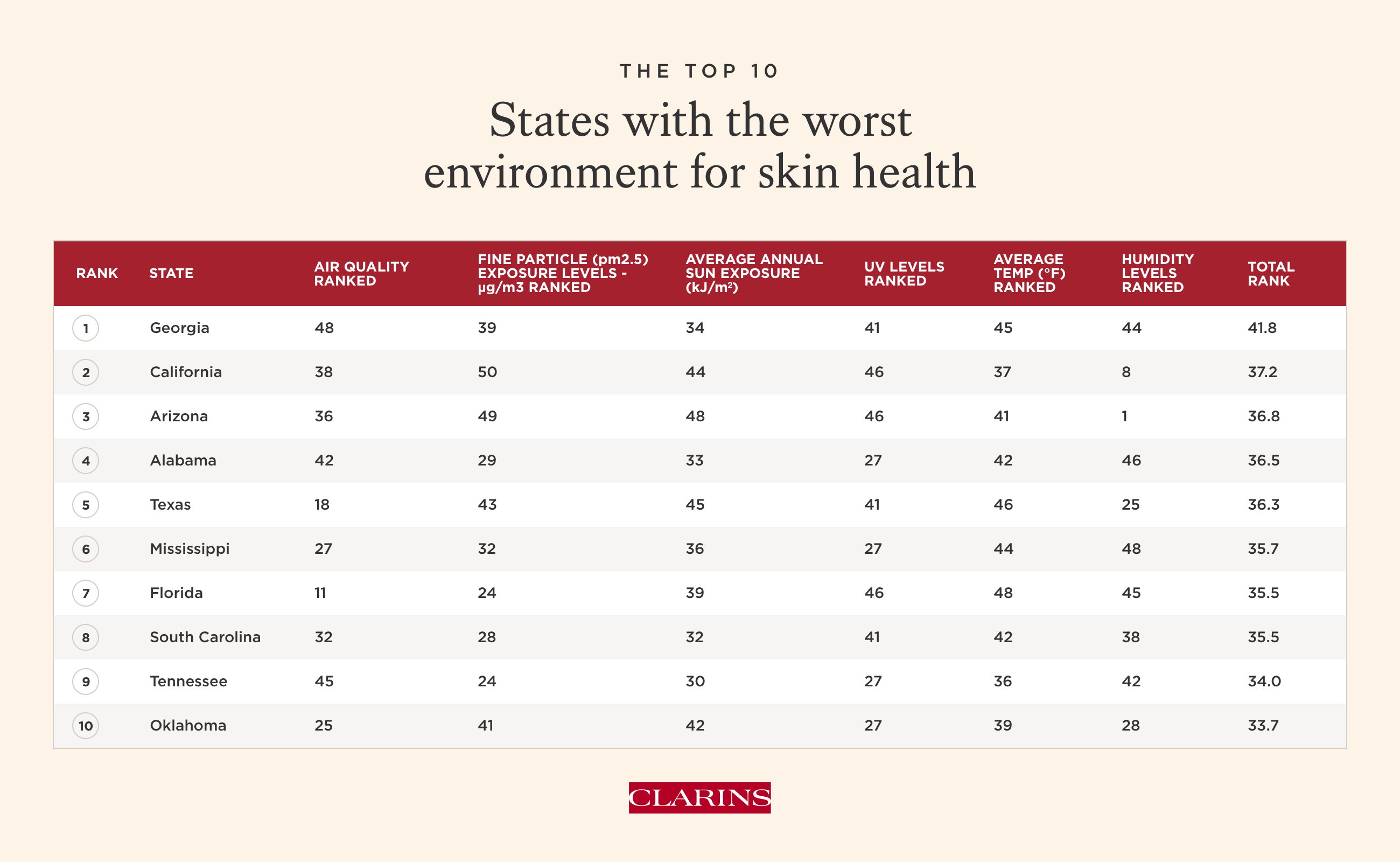
The data we analyzed uncovered the southeastern state of Georgia as the overall worst state for skin health, scoring an eye-watering 41.8 out of 50.
Air quality in Georgia scored 48 out of 50 with an exposure level of 8.6 PM2.5. The traffic and hot weather of the state could be key contributors to its lower air quality.
The state’s UV level of 8 is considered very high by the United States Environmental Protection Agency (EPA) and scored 45 out of 50 in our data for average temperature. Georgia also ranked high for its humidity level at 85%, just 4% below Mississippi, the most humid state in America.
Perhaps surprisingly, The Golden State, California, is the second worst state environmentally for skin health. Despite its infamous reputation as the home of celebrities and beauty perfection, the state of California had the highest levels of fine particle pollution in America at 13.4 PM2.5. It also had a sizzling UV Level of 10, the highest number of all states.
The southwestern state of Arizona ranked as the third worst state for skin health. Like its neighbor, California, Arizona also scored the highest UV Level among states in our analysis at a scorching 10, ranking highly for fine particle pollution and average annual sun exposure.
While the states that performed highly for skin health concentrated in the northeast of America, the worst states to live in for skin health were in the South and on the West Coast, which is unsurprising when looking at the levels of sun exposure and temperature in these hotter locations.
The Best and Worst States for Skin Health by Sun Exposer and UV Levels
Overexposure to the sun can result in our skin absorbing too much UV radiation, leading to dehydration, quicker aging, and, in the worst case, skin cancer.
To protect against harmful rays while enjoying the sun, we recommend using a broad-spectrum sunscreen with an SPF of 30+, regularly reapplying, and staying out of direct sunlight during the hottest parts of the day.
Clarins’ UV Plus SPF 50 Anti Pollution Face Sunscreen is the perfect daily companion, especially for those traveling to states with additional high levels of pollution. The lightweight, oil-free sunscreen works for dry, combination, and oily skin with a triple action that protects against indoor and outdoor pollutants, locking out sunburn and damaging UVA & UVB rays.
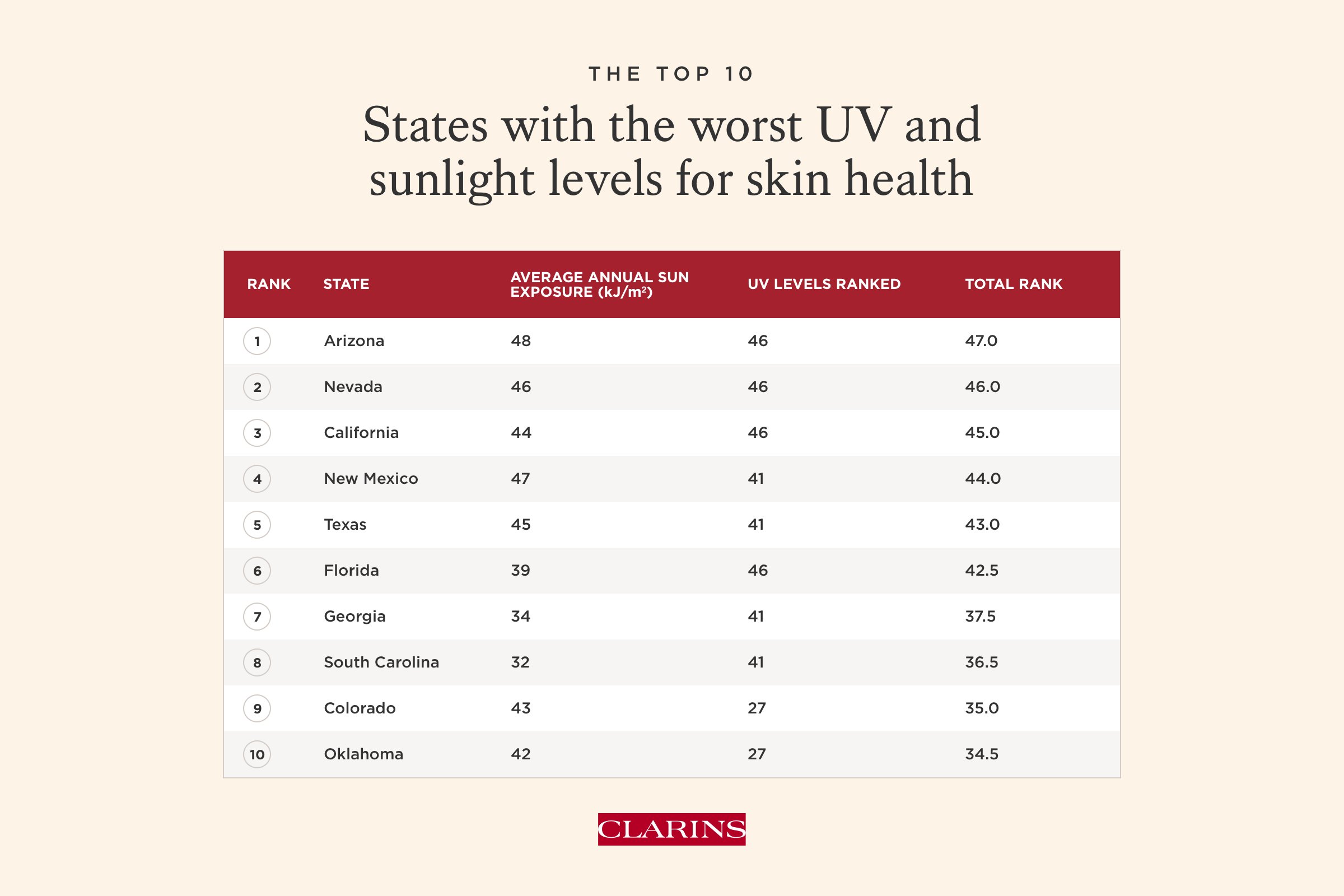
Arizona tops the list of states with the worst levels of sunlight and UV. Famed for the Grand Canyon, millions of tourists travel to the state yearly and should remember to pack their sunscreen with them!
Our analysis scored Arizona 47 out of 50 for its UV levels and average annual sun exposure. Perhaps unsurprisingly, due to their geographical closeness, Arizona's neighbors Nevada and California rank second and third, respectively, as the states with the worst sunlight and UV levels.
Nevada scored a whopping 46 out of 50 on average sun exposure and UV levels, while The Golden State, California, scored 44 out of 50 for average annual sun exposure matching Nevada with 46 out of 59 for UV levels.
An SPF-tinted moisturizer is essential packing for travelers heading out west this summer, who can benefit from the added protection of swapping out their regular foundation with a more comfortable, lightweight product that adds an extra layer of SPF protection.
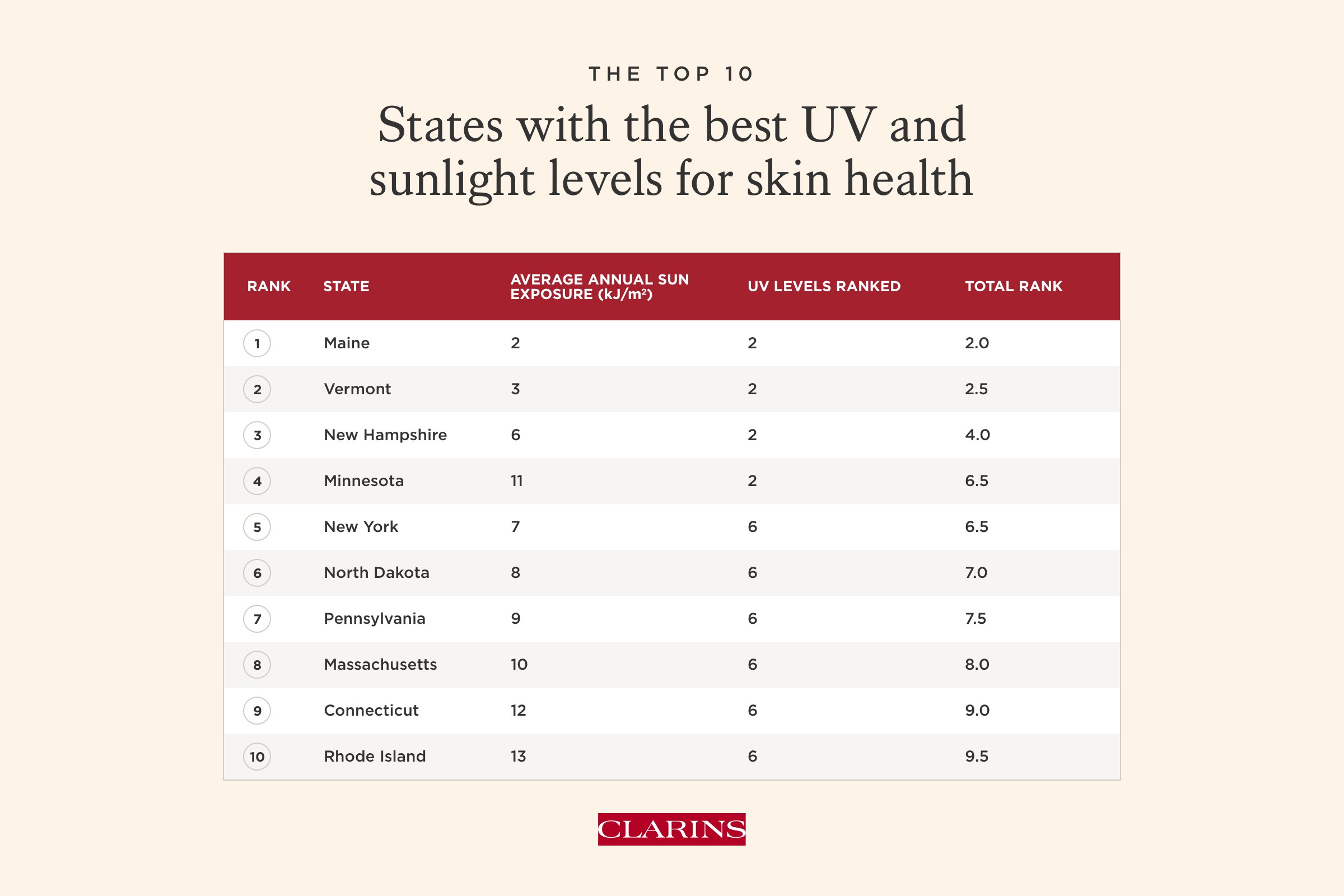
Maine, the overall best state to live in for skin health, unsurprisingly tops our list as the best state to live in for limited sunlight and UV exposure.
With a UV score of just 2 out of 50, Maine has a UV level of 6, regarded as moderate-high by the EPA. This, of course, doesn't remove the need for sun protection as exposure to any level of moderate sun requires a broad spectrum SPF 30+ sunscreen.
The Northeastern states of Vermont and New Hampshire placed second and third as the best states for skin health in terms of sun and UV exposure also scoring 2 out of 50.
The Best and Worst States for Skin Health by Air Quality
Our skin is our largest organ and a protective shield that keeps pollutants and nasty germs from entering our body. While skin can filter a lot of environmental stressors, long periods of overexposure to poor air quality can disrupt the skin microbiome, resulting in dehydration, premature aging, and conditions like acne and eczema.
The right skincare routine can help to support your skin microbiome and protect against harsh pollutants. We suggest starting with Clarins Velvet Facial Milk Cleanser to remove makeup/pollutants and boost hydration gently; use morning and evening to help preserve a healthy balance of the skin's microbiota, especially in states with poorer air quality.
Worst States for Skin Health by Air Quality and Pollution Levels
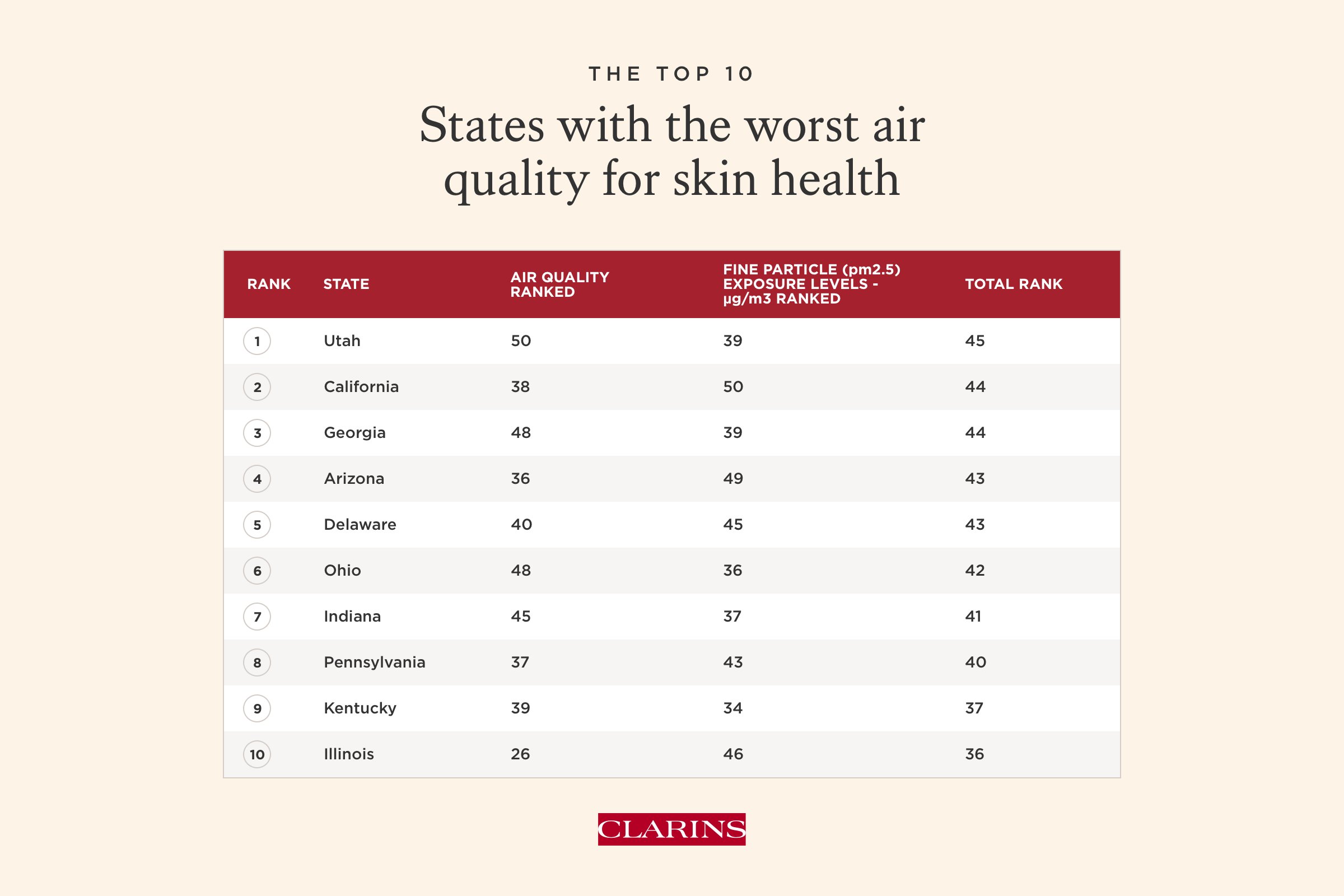
Utah ranks first for states with the worst air quality. Our analysis uncovered that it has the lowest number of good air quality days and an 8.6 fine particle (PM2.5) exposure level.
Emissions and the geographical landscape all play a role in Utah’s poor air quality, with PM2.5 being the biggest pollutant in the winter and Ozone the largest in the summer.
California ranks as the state with the second worst air quality, with a 13.4 fine particle (PM2.5) exposure level. Wildfires, vehicle emissions, and fossil fuels are all factors in the poor air quality.
Georgia tops off the rankings of the worst states for air pollution, coming in third, with busy roads a leading cause. Fine particle (PM2.5) exposure levels stand at 8.6 in The Peach State (the same as Utah), with the second lowest number of good air quality days scoring a mighty 48 out of 50 from our research.
Best States for Skin Health by Air Quality and Pollution Levels
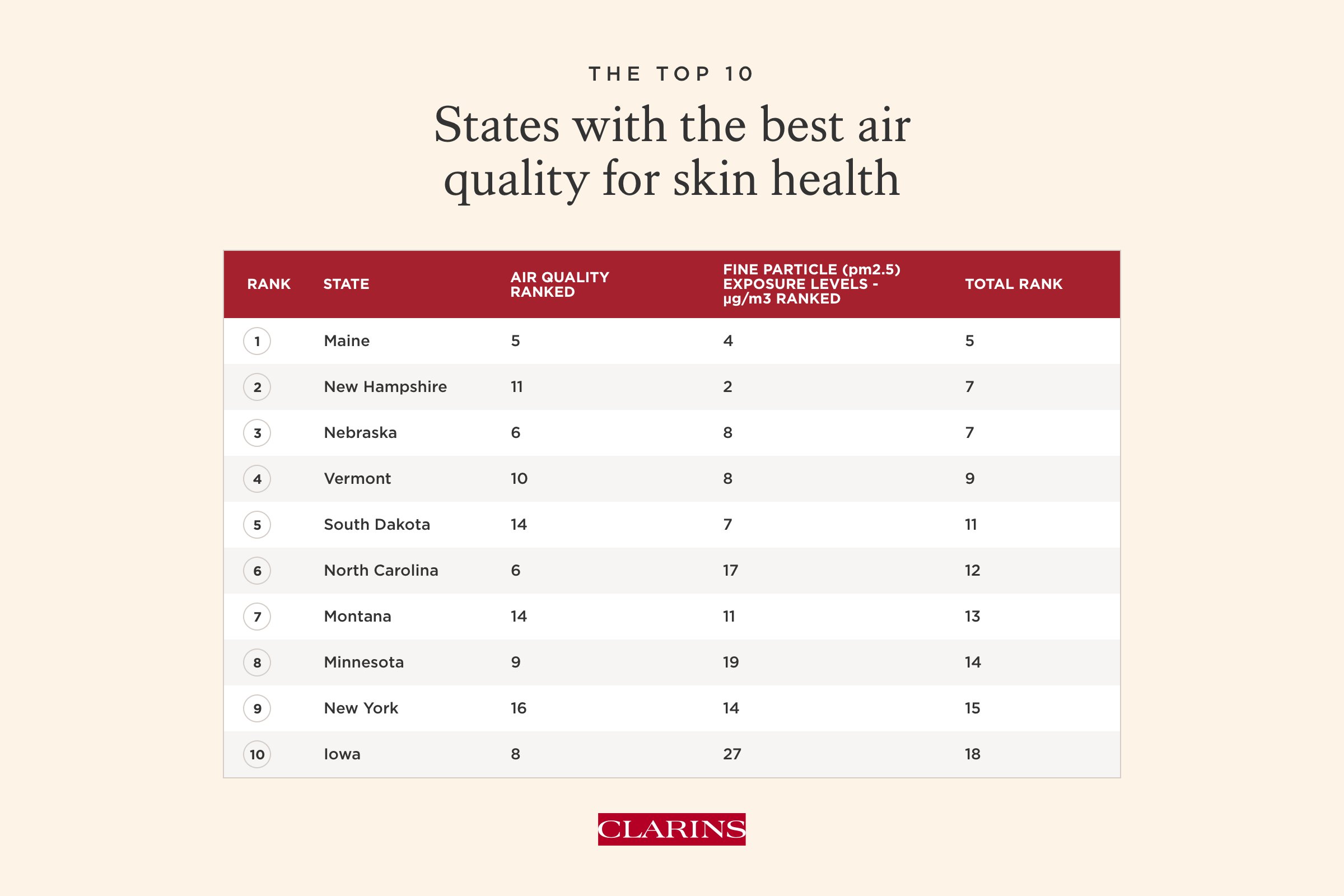
On the flip side, Maine, famed for its pine trees and beautiful landscape, tops our list as the best state for air quality with low levels of pollution. Our analysis scored the state 5 out of 50 for good air quality days with a 5.4 fine particle (PM2.5) exposure level.
Our research found New Hampshire to be the second-best state to live in for skin health in terms of air quality and pollution. With a fine particle (PM2.5) exposure level of just 4.9, the lowest of all states!
And, Nebraskans can breathe a sigh of relief as they rank as the third best state to live in for skin health based on air quality and pollution. Our data scored the state 6 out of 50 for good air quality days, with its 5.9 fine particle (PM2.5) exposure level.
Tips for protecting your skin from environmental stressors
Ultimately, no matter where you live, it is important to protect your skin against environmental stressors with a routine that protects against sun damage, UV rays, and pollution.
Clarins skincare experts have offered several tips to protect your skin against environmental stressors.
Remove Impurities
Cleanse your face thoroughly to remove impurities. Both the sun and pollution can dehydrate your skin, so using a cleanser with hydration power is essential.
We recommend using our Velvet Facial Milk Cleanser morning and evening to preserve skin microbiota, leaving it soft, clean, and prepped for the rest of your routine.
Reinforce your skin barrier
Hydrating your skin helps to support your skin barrier, and using a moisturizer with SPF and anti-pollution properties can go a long way in reinforcing protection against nast pollutants and sun damage.
If you want skin protection with an added healthy glow but need something more lightweight than foundation, try our UV PLUS Anti-Pollution Broad Spectrum SPF 50 Tinted Sunscreen Multi-Protection.
Don’t leave your sunscreen at home
Remember, SPF needs to be reapplied throughout the day to maintain its protection, so keep a travel-sized sunscreen to hand that you can use to top up during the sizzling summer months.
Never sleep in your makeup
It is one of the beauty golden rules worth repeating - never sleep in your makeup. Cleansing your face before bed is vital to remove an array of impurities from your skin, many of which are invisible!
If you don’t have the time (or energy) before bed to wash your face in the basin, try our Cleansing Micellar Water Face Makeup Remover. The refreshing formula quickly removes makeup, pollutants, and grime all in one step with no need to rinse, you’re welcome.
*Methodology & Data Sources
Data was taken from the most recent environmental reports for each state. The states did not include Hawaii and Alaska due to a lack of sources.
The metrics of UV rays, air quality, pollution, humidity, and average temperature were selected for analysis were chosen based on their specific impact on skin health.
Air Quality Score: https://worldpopulationreview.com/state-rankings/air-quality-by-state
Average exposure of the public to fine particulate matter (PM2.5) pollution levels: https://www.statista.com/statistics/1447785/united-states-pm25-air-pollution-exposure-by-state/
UV Index: https://www.epa.gov/sunsafety/sun-safety-monthly-average-uv-index-2006-2023
Sun Exposure: https://ephtracking.cdc.gov/indicatorPages?selectedContentAreaAbbreviation=26&selectedIndicatorId=135&selectedMeasureId=
Temperature and Humidity: https://www.ncei.noaa.gov/access/monitoring/climate-at-a-glance/statewide/rankings
Related Questions
How can I tighten my pores?
There are many factors that influence the size of your pores. Read on to discover what they are and how to shrink the appearance of pores.
READ MORE
How do I fight the signs of aging on my body?
Aging is inevitable but can you slow it down? We have the best anti aging skin care line to help you maintain your youthful glow. Find out more.
READ MORE
How to get glowing skin?
Depending on the season, your skin is exposed to harsh environmental influences like sun, cold, wind, pollution, heating, air-conditioning, or sudden temperature swings—aggressors that can leave it looking dry, dull and weathered…old before its time.
READ MORE
How often should I exfoliate?
Exfoliation forms an essential part of your beauty routine. Here’s how Clarins exfoliation products can make your skin more radiant.
READ MORE
How do I know if my skin is sensitive?
Sensitive skin can easily be thrown off balance – but read on to find out how to manage the condition starting with the right face wash for sensitive skin.
READ MORE
Why do I need a targeted eye cream?
Eyes are one of the most expressive parts of your body, but they’re also one of the most prone to aging. Here’s why under-eye creams are so essential.
READ MORE
How to protect your skin from stress aging
Learn how stress and heightened cortisol levels can visibly impact your skin. Clarins Experts provide skincare advice to help reduce the risks of aging from stressed skin.
READ MORE
What night skin care steps does Clarins recommend?
A Clarins' night cream is a wonderful treat no matter your skin type. Learn how to get visibly renewed skin and a radiant-looking complexion.
READ MORE
How do I take care of my mature skin?
Just because you have mature skin, doesn’t mean that it has to look it! Have a look at how Clarins’ anti aging products can help you reduce the risk of premature aging signs.
READ MORE
Can I use the same product both at night and during the day?
Day creams and night creams have completely different roles. Here’s how and why you should be using them both in your skin care routine.
READ MORE
Is it possible to visibly firm up my skin?
Skin starts to sag as we age, luckily there are a number of ways to get your smooth skin back. Clarins has the best firming lotions that are refreshingly addictive. Find out more.
READ MORE
What can I do for very dry skin?
Dry itchy skin is uncomfortable and unsightly. Read on to find out how the best skincare routine for dry skin can turn dry skin into visibly smooth skin.
READ MORE
What are the best ways to care for my hands?
Wondering how to keep your hands soft, supple, protected from the sun, and moisturized? We answer your most common questions about how to care for your hands.
READ MORE
What is the best way to moisturize my body?
If you think the only way to get smooth skin is with a photo editing app – read on to discover how body scrub, lotion, and moisturizer can unlock your best skin.
READ MORE

